Across time and throughout different cultures, there is one bird family in particular that holds particular symbolism and significance: the Woodpecker bird. While some cultures associate this bird with prosperity and luck, others have imposed symbols of perseverance and determination on this bird.
Typically in the past, Woodpeckers were purely seen as birds of omen or symbolic birds. It is hard to find a civilization that has not placed significance on this bird in one form or another.
Associated with a plethora of positive symbols like opportunity, strength, wishes, spiritual learning, and hard work, Woodpeckers, have always kept the interest of man.
However one wants to see it, Woodpeckers are fascinating creatures having interesting lives and life cycles. They are considered some of the most intelligent and sentient birds in the entire class of birds.
Physical Appearance
While it may take an ornithologist to recognize and accurately classify all of the diverse species that fall under the class Aves (or birds), even a little kid can immediately yell, “A Woodpecker bird!” when they see one in a picture book or on the TV.
While each specie of Woodpecker bird might vary in color and size, most Woodpeckers have a quintessential appearance. All Woodpecker species have characteristic sharp beaks that they use as chisels to search for food in woods and tree trunks.
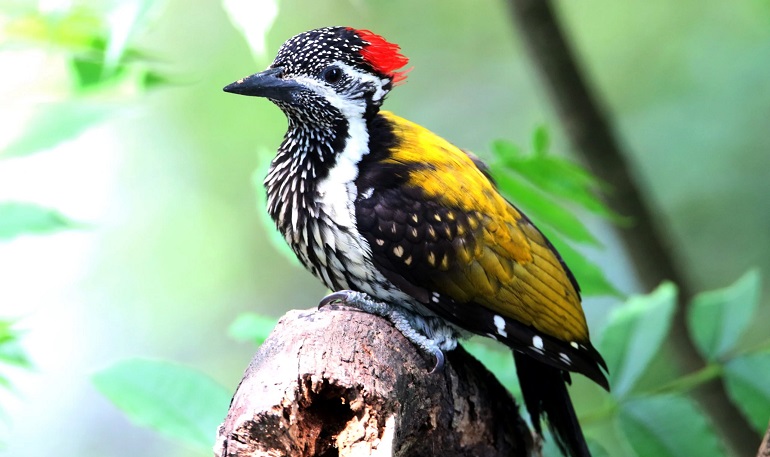
Although each specie can have its own set of colors on the body, most Woodpeckers have black-colored feathers all over their body – complemented by a red patch on their head.
There are some species whose entire head is covered by the red crest – such as the Magellanic and Red Headed Woodpecker.
General Characteristics
While it may be hard to unify the traits of the one-hundred and eighty species in this family, a few common characteristics are generally observed through all of the birds in this subclass. Here we will be sharing some of the characteristics of these interesting birds:
- Some might consider Woodpeckers as just one bird, but it is a subclass consisting of 180 species, including flickers and sapsuckers!
- Woodpeckers might look like songbirds, but scientists classify these birds in different categories.
- The Woodpeckers are related to Toucans! (Yes, now the big bleak thing has started to make sense)
- They can be found almost worldwide, mostly in South America and Southeast Asia.
- Most Woodpeckers feed on insects that are harmful to the trees; hence their hunting is actually very beneficial and safe.
- They vary in length. Most might have a length between 6 to 18 inches.
Habitat Requirements
Most of the birds belonging to this class have diverse habitats across the globe and can be found evenly distributed in different regions.
All Woodpeckers are arboreal, meaning they nest primarily in woods and trees. In tropical rainforests, they can be found in maximum numbers and diversity due to the greater number of wooden habitats.
Being good at adaptability, they are suitable for all-natural habitats, such as grasslands, bamboo forests, and scrublands. Even grasslands and deserts are home to some species of Woodpeckers.
Some species are ‘specialists’ and associate with specific deciduous or coniferous woodlands. In contrast, others are generalists and can adapt to several natural settings such as parks and plantations.
Woodpecker species that live in forests require dead wood to forage.
Diet and Feeding
When one of the cameramen of National Geographic zooms in on a Woodpecker bird, it is mostly them pecking on different tree trunks. This has created and maintained the belief that this noisy desert bird is feeding on the wood!
Woodpeckers do not feed on the wood but peck the woods to feed on the insects inside or to find a comfortable habitat away from predators.
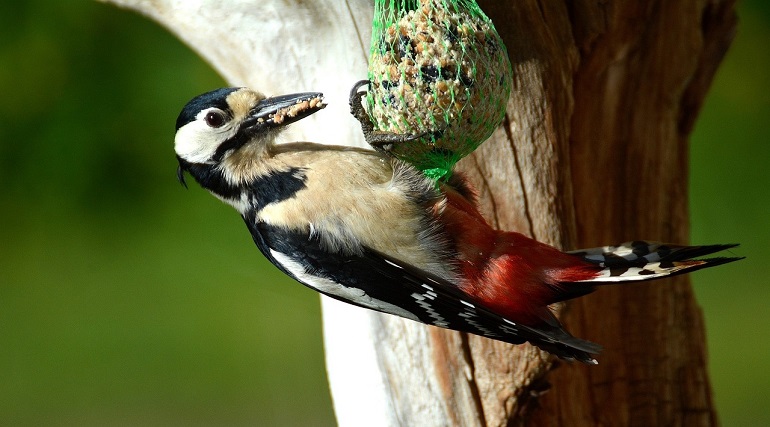
Now, the important question arises: what do Woodpeckers eat? Woodpeckers generally feed on wood-boring insects such as bugs, beetles, and other larvae. However, in winter, insects are not found in abundance. So, Woodpeckers switch to nuts, berries, seeds, and other fruits.
The exact food and nutritional needs might vary from specie to specie; the general foods given to Woodpeckers include black oil sunflower seeds, peanut butter, nectar, corn, sap, suet, insects, etc.
Behavior
Birds belonging to the Woodpecker family exhibit several behaviors in varying degrees. While other species might show extremely low levels of social behavior and live solitary lives, some form groups and complete their life cycles in them.
Woodpeckers sometimes show aggressive and extremely anti-social behaviors such as wing flicking, vocalizations, drumming, and head shaking – even to members of their own specie.
Woodpeckers also show nesting behavior. While the nest type and cycle vary greatly between each specie, generally, all Woodpeckers prefer to build their nests inside tree trunks, including pines, maples, cottonwoods, and oaks.
Apart from nesting in the aforementioned habitats, Woodpeckers can also make use of old snags without most of their bark to create a smooth surface to scare away snakes.
Woodpeckers also make simple sounds and calls, usually by both sexes, to communicate danger, alarm, courtship, or dispute.
Types of Woodpeckers
All Woodpeckers belong to the same family: Picidae and its subfamily Picinae (true Woodpeckers). This family also includes piculets, sapsuckers, and wrynecks.
Each specie that falls under this family category has its own distinct behavior, appearance, life cycle, habitat, and feeding style.
Here are the details of some of the prominent Woodpecker species.
Red-Bellied Woodpecker
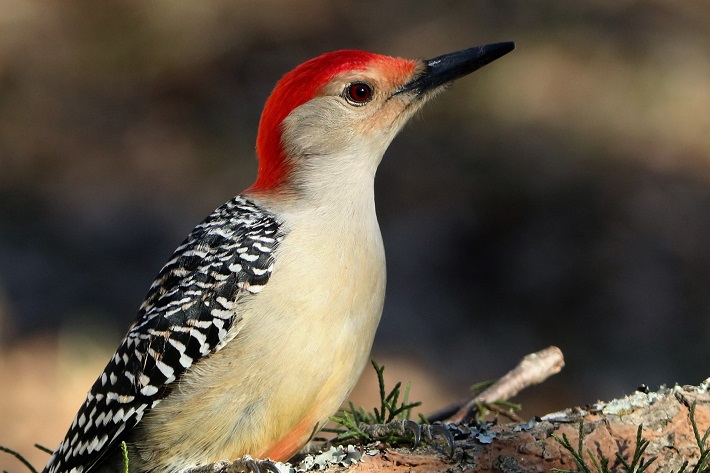
The Red Bellied Woodpecker is a member of the family Picidae. It is medium-sized and resides mostly in the Eastern parts of the United States, as far North as Canada and as far South as Florida.
It has its own characteristic appearance of a bright orange or red crown and neck. The Red Bellied Woodpecker is often confused with Red Headed Woodpecker – a completely different specie of Woodpecker having an entirely red head. The Red Bellied Woodpecker got its name from the light red dust on its underside.
As is the case with its kin, foraging is of utmost importance for this Woodpecker. It expresses foraging by storing or catching foods. Using its long beak as a chisel, it probes the tree trunks for food.
It exhibits different drumming patterns to begin its breeding activities at the beginning of May. The Red Bellied Woodpeckers also show nesting behavior and use dead and drying wood for this purpose. By excavating nesting cavities, they play a positive role in a forest community.
Downy Woodpecker

The Downy Woodpeckers is one of the species of woodpeckers in North America. It is the smallest of its kind in Latin America – with its length ranging from fourteen to eighteen centimeters (14-18 cm).
The appearance of Downy Woodpecker resembles the Hairy Woodpecker so much, even though they do not share a close relationship or ancestry. It is mainly black in wings and the upper part, except its throat and belly, which sport a white spotting.
They have a distinct white bar above and below the eye. In addition, the adult males have a red patch on the back of their heads.
The Downy Woodpecker primarily resides in forests or forest-based habitats in US and Canada. They primarily live in wooden cavities and prey on small insects, sometimes opting for seeds and berries. They use their stiff tail feathers as a tripod stand to balance themselves. Their tail feathers are pointed with a forked appearance.
Hairy Woodpeckers
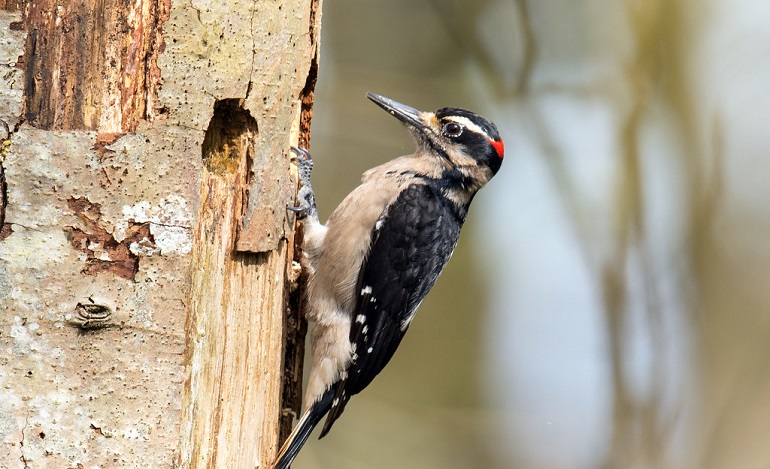
The Hairy Woodpecker is another species of Woodpeckers in North America. They cover a large landmass of North America, with an estimated population of almost nine million birds worldwide.
When it comes to appearance, the Hairy Woodpecker is mainly black on the upper side and the wings. However, depending on the subspecies, some members might have a belly and throat from white to dingy brown. They also sport a pale black or white dusting on the wings.
They inhabit several ecosystems like Deciduous forests in Canada, the US, Mexico, Panama, and Costa Rica.
Their primary foraging resource is trees. They turn over bark or excavate it to find food in the form of insects. They also feed on other things like berries, fruits, tree sap, and nuts.
They are also used in the population control of the European Corn Borer Moth.
Northern Flickers
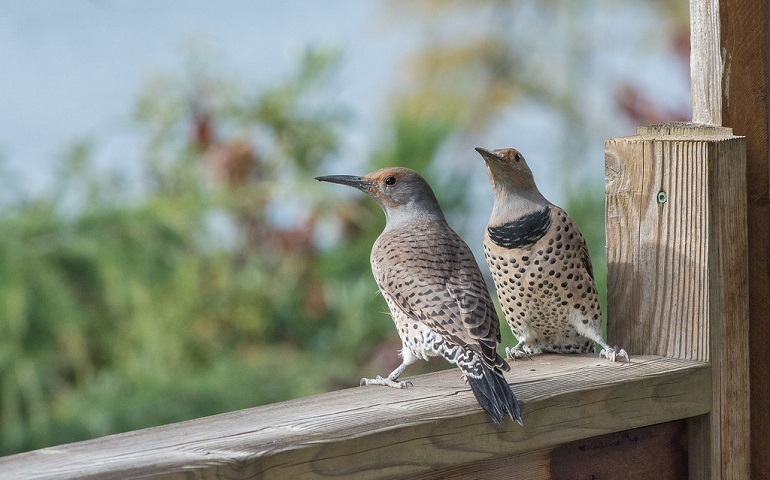
The Northern Flicker is a specie of Woodpecker that is native to most parts of North America, some parts of Central America, Cuba, and the Cayman Islands. It is one of the only species of Woodpeckers that migrate.
Adult birds of this specie are brown with black lines on the backside and wings. They are medium-sized, with their length ranging from twenty-eight to thirty-six centimeters (28-36 cm). The wingspan is about forty-two to fifty-four centimeters (42-54 cm).
Flickers are one of the few species of Woodpeckers that feed on the ground. They probe the ground with their beaks and sometimes catch insects in their flight. Although insects constitute the major portion of their diet, they also feed on berries, seeds, nuts, and fruits.
Northern Flickers are found in open habitats near trees, such as yards and woodlands. They also exhibit nesting behavior and nest in nesting sites like other Woodpeckers.
Pileated Woodpeckers
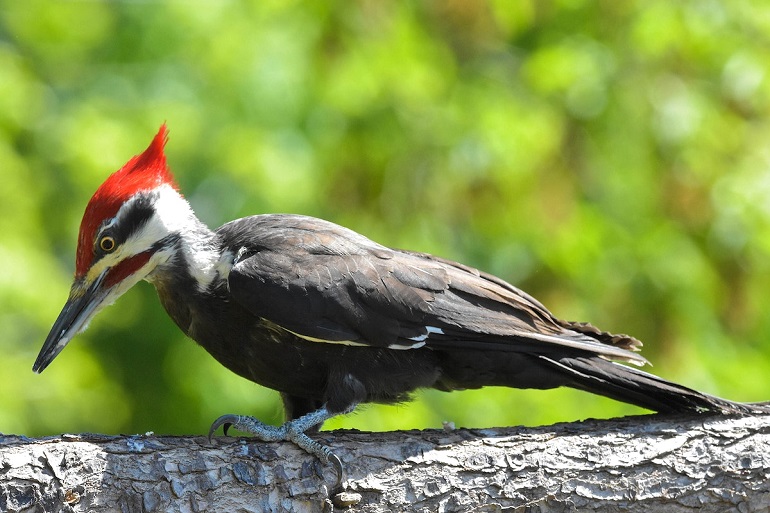
The Pileated Woodpecker is a specie that is native to North America. It inhabits Deciduous forests in Eastern North America, the Great Lakes, and parts of the Pacific Coast. It is also the third largest Woodpecker species in the world.
The Pileated Woodpecker has earned its name from the red crest that is its prominent feature. The Northern birds of this specie are slightly larger than the southern ones. They are mainly black with a red crest. The Pileated Woodpecker has a white line along the two sides of its throat.
This specie feeds mainly on insects and wood-boring larvae of beetles. However, they also feed on berries, nuts, poison ivies, and other fruits.
When it comes to nesting, they excavate large nests in the holes of dead trees.
Acorn Woodpeckers
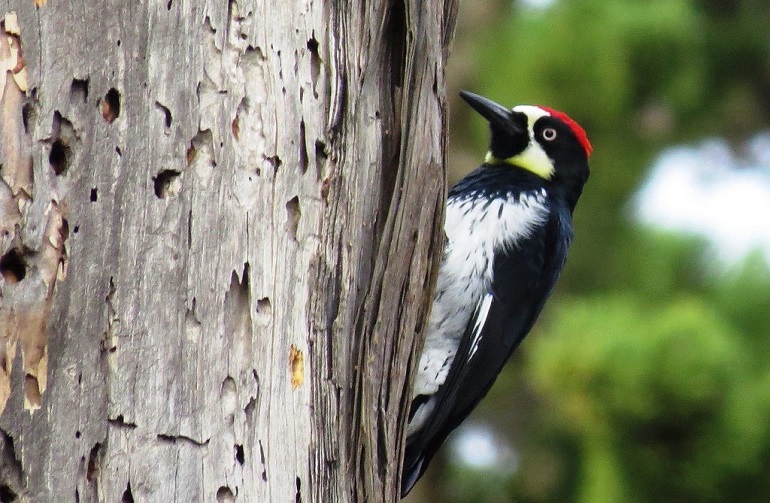
The Acorn Woodpecker is a medium-sized species belonging to the family of Woodpecker birds. The unique birds belonging to this specie have black or brown head. The rest of their body is also brownish black.
The eyes of a juvenile acorn woodpecker are dark, but they eventually turn dark. A few green feathers are present on a small part at the back of their heads. Males have a red cap, while females have a black area between the forehead and the cap.
Acorn Woodpeckers reside in forested areas such as the coastal regions of Oregon, California, and the Southwestern United States.
They show cooperative behavior when it comes to breeding. They live and breed in family groups of up to fifteen individuals. An acorn woodpecker also has a distinct call that sounds like a peal of laughter.
American Three-Toed Woodpecker
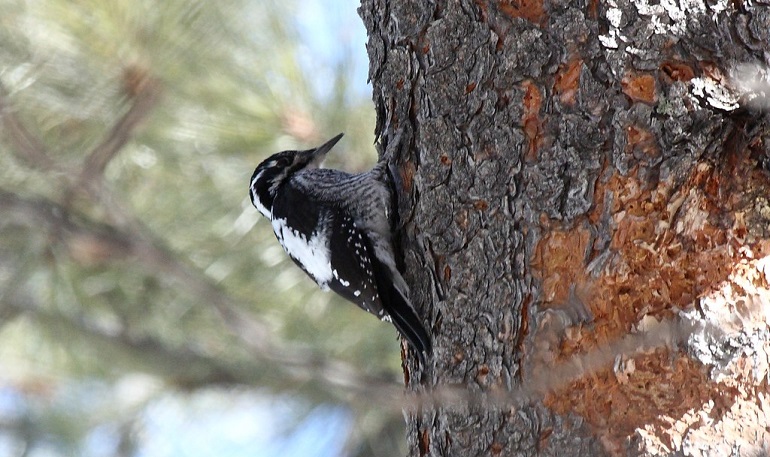
This bird species belonging to the family of Woodpeckers are medium in size. It is native to North America. It closely resembles the Black-Backed Woodpecker, which also has three toes.
An adult American Three-Toed Woodpecker is black on the head, wings, and rump. It is white in color from its throat to the belly. The flanks are white with black lines. The adult male also has a yellow cap.
This bird normally resides in one place, but some birds might migrate. These birds feed on wood-boring beetle larvae or other insects in conifers.
American Three-Toed Woodpeckers also show different behaviors, such as competition and nesting. They compete with Black-Backed Woodpeckers for habitat.
Ladder Backed Woodpeckers
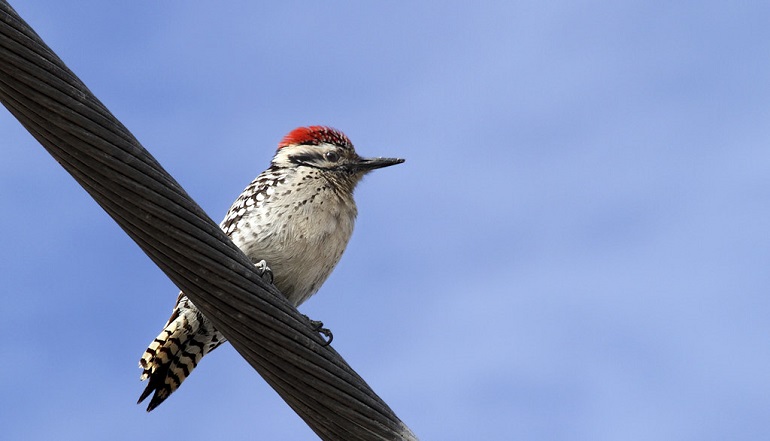
The Ladder-Backed Woodpecker in North America is a small Woodpecker that is about 16.5 to 19 cm in length. It is colored black and white primarily. Its back sports a barred pattern, and its wings resemble the rungs of a ladder.
The rump of Ladder Backed Woodpecker has a black color, as do its cream-colored underside of breasts and flanks. In addition, adult males have a patch of red crown absent in females.
The Ladder-Backed Woodpecker can easily be found in dry bushes and thickets. This specie can be found in the Southwestern United States, New Mexico, and Central America.
White Headed Woodpeckers
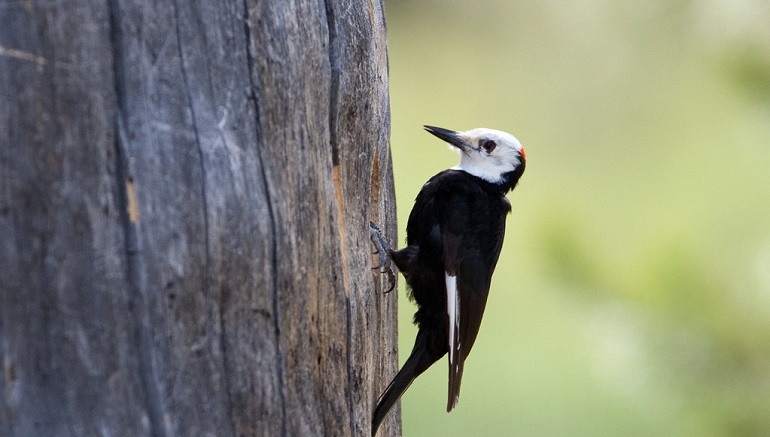
This non-migratory specie of Woodpecker lives in pine trees or forests of Western North America.
The body of this bird is covered in black color, and the head is white. The primary feature of these birds is that they form the shape of a crescent during their flight. The adult males have a red spot at the back of their heads.
They can be found in the mountains of British Columbia to Southern California. They live in nests in dead trees or snags. They reproduce just once per year.
This glossy black bird feeds heavily on large oak trees and their seeds and is most commonly found in association with sugar pine forests and ponderosa pines. They do not drill into trees for insects but probe into needle clusters.
The male and the female members of this specie incubate the egg, with the male performing the night-time duties.
Gila Woodpecker
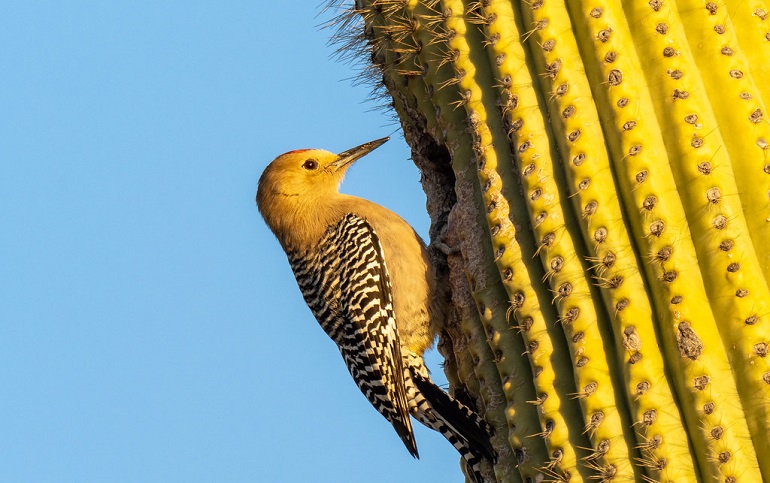
The Gila Woodpecker is a medium-sized bird that belongs to the family of Woodpeckers. It resides in the Southwestern United States and Western Mexico desert regions.
This bird’s back and wings are barred with a zebra-like pattern of black and white. The rest of the body, including its neck, throat, belly, and head, is greyish. The adult male birds have a small red cap on the top of their heads. Both the females and young birds lack the red cap.
Their habitat is low desert scrub like that in the Sonoran Desert, as well as washes and small towns. They exhibit nesting behavior in holes in Mesquite trees or Saguaro cactuses. They are also spotted at hummingbird feeders but forage on fruit and bugs.
Ivory Billed Woodpecker
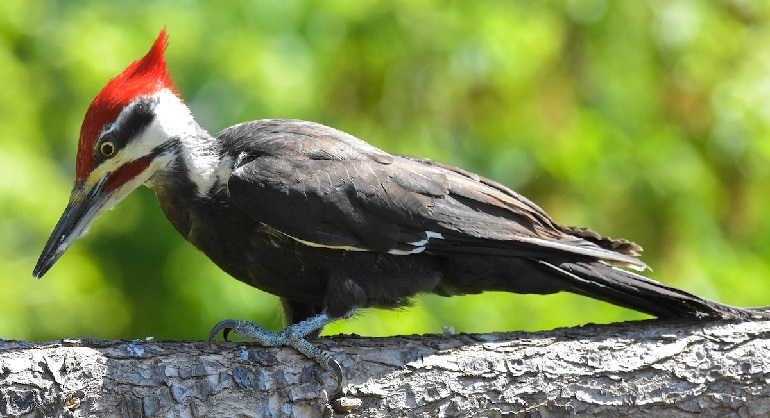
The last specie on our list is Ivory Billed Woodpecker – possibly an extinct specie. It is native to hardwood and temperate coniferous forests of the Southern United States and Cuba.
Possible reasons for its potential extinction are habitat destruction and overhunting.
The preferred diet of Ivory Billed Woodpeckers consists of large beetle larvae, particularly the wood-boring beetles. The diet is supplemented by vegetable matter and varied fruits such as acorns, hickory nuts, and wild grapes.
It was, or is, one of the largest Woodpeckers in the world. The plumage was shiny black or purple tint. White lines extend from the cheeks and down the neck and meet at the back. The ends of its primary features are also white.
Relationship With Humans
Woodpeckers generally share a relatively favorable relationship with humans. They are generally seen as interesting birds capable of showing engrossing behavior.
But there are some activities of these birds that cause harm to humans. One of these activities is drilling nest holes in buildings, wooden fences, and utility poles, which can cause monetary damage to these structures.
Another such activity is their foraging habits when they raid fruit crops. But it also turns out to be beneficial as they control the populations of insect pests such as wood-boring beetles that can kill trees.
They also cause damage by drumming on reverberatory structures such as chimneys, vents, and gutters.
How Will Climate Change Reshape The Range Of Woodpecker Birds?
Climate Change has an adverse effect on the habitats of all animals, and the Woodpecker birds are sadly no different.
Overall, several species of this family will lose their habitat by the end of this century due to climate-induced changes in the landscape, temperature, and other factors.
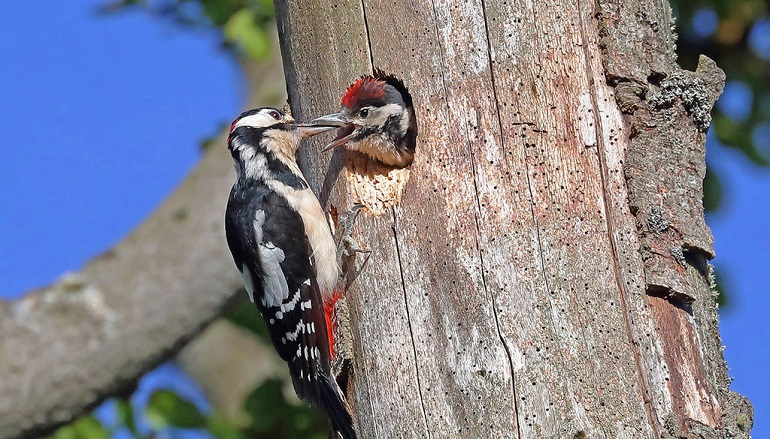
And many experts propose that even with net gains, an overwhelming majority of the species are labeled as threatened or critically endangered.
Importance of Woodpeckers in the Ecosystem
Besides being fun to watch, Woodpeckers also play a key role in the ecosystem. They provide several important services to songbirds, waterfowl, birds of prey, and even other Woodpeckers.
They are primary cavity nesters, which means they drill nesting cavities from scratch. This habit provides many nesting cavities that secondary cavity nesters can occupy.
They provide services such as pest control, food for humans, prey for avian predators, and even ecotourism funds. All these services are essential to keep the ecosystem balanced and harmonious.
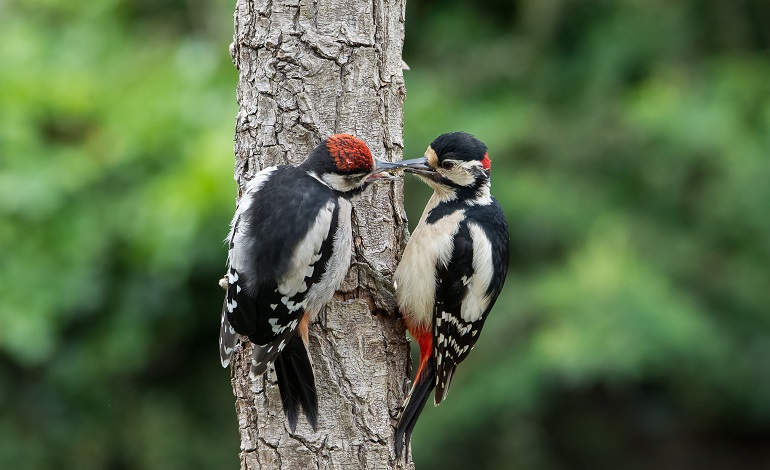
What Can You Do To Help Bird Conservation?
Birds play a pivotal role in a number of biogeochemical cycles and hence keep the environment running perfectly. Unfortunately, many of these birds have been endangered due to climate change, and some have even gone extinct.
Following are a few easy steps that you can take to play your part in saving and conserving the birds’ species:
- Make windows safer for the local birds
- Keep cats indoors
- Garden with native plants
- Reduce your carbon footprint
- Join conservation groups
Common Woodpecker Health Problems
Even though Woodpeckers are generally healthy birds, there are a few health problems that these birds are disposed towards. One of these conditions is avian malaria. It can even be fatal for these birds in some cases.
Some of the other such diseases are West Nile Virus and Lyme disease. They are also prone to injuries. If you find any injured or sick birds, you should take them to a vet to get them the care they need.
Final Thoughts
Woodpeckers are one of the most intriguing bird species that are a delight and even a necessity to have in the ecosystem. They play a vital role in the ecosystem in many ways.
If you are lucky enough to have witnessed one in the wild, you should take your time to cherish and appreciate its beauty!












